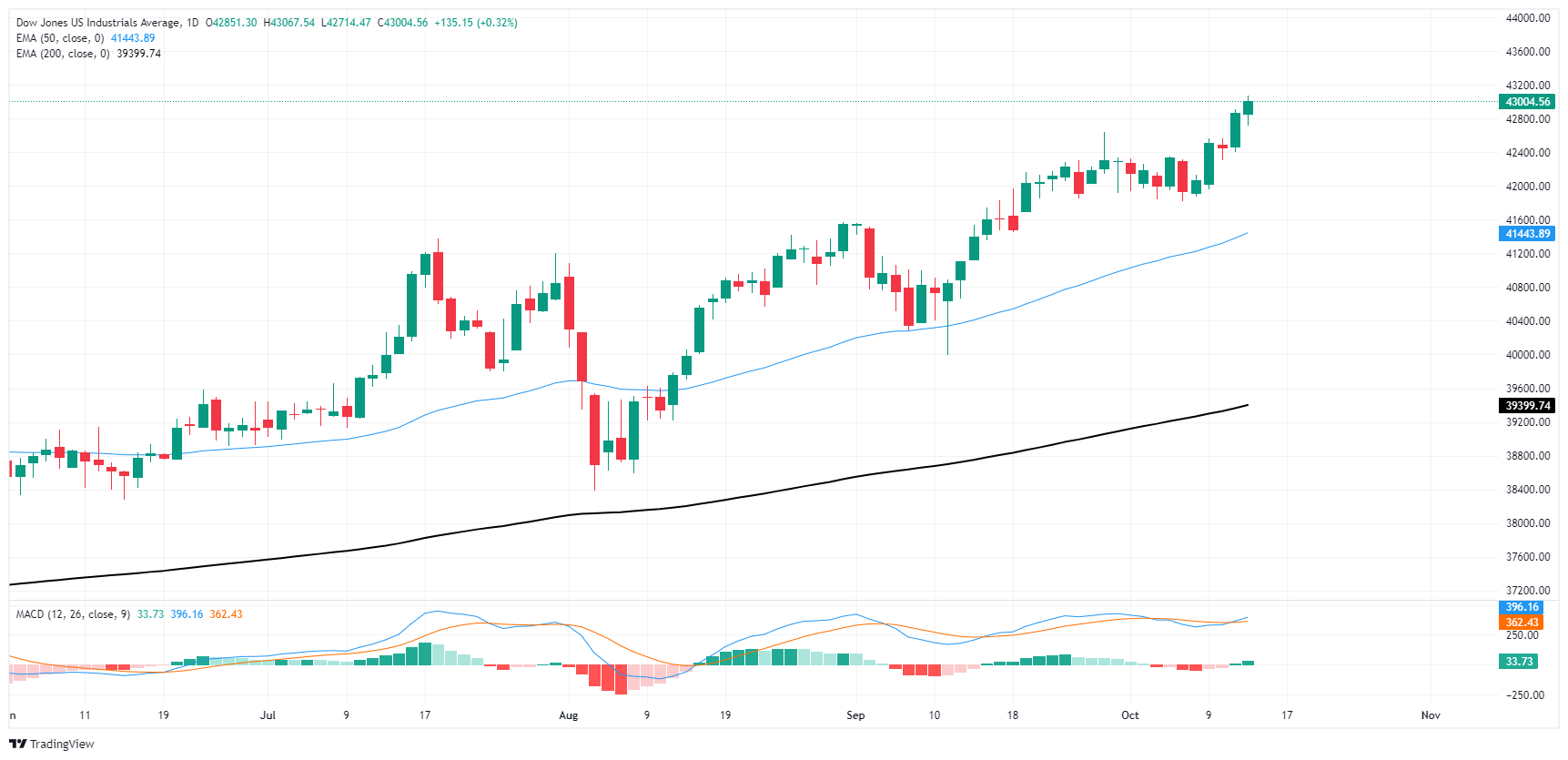- The Dow Jones found a new all-time high at the start of the week.
- Investors have shifted more firmly toward risk appetite ahead of a week of strong gains.
- The Dow Jones has gained more than 12% since the August low.
The Dow Jones Industrial Average (DJIA) rose to another all-time high on Columbus Day Monday, testing above the 43,000 zone and set to enter its sixth consecutive week in the green. Wall Street is gearing up for a choppy week of earnings reports, and this week’s U.S. data agenda includes a series of appearances from mid-level Federal Reserve (Fed) policymakers, with figures key US retail sales scheduled for Thursday.
JPMorgan Chase (JPM) and Wells Fargo (WFC) kicked off earnings season late last week with strong results, and markets expect more of the same from the rest of the banking sector. Bank of America (BAC) and Goldman Sachs (GS) will report third-quarter earnings on Tuesday, along with pharmaceutical giant Johnson & Johnson (JNJ). Morgan Stanley (MS) will round out financial sector gains on Wednesday along with United Airlines (UAL), with Walgreens Boots Alliance (WBA), Netflix (NFLX) and Proctor & Gamble (PG) scheduled for later in the week.
Dow Jones News
Despite a firm move into bullish territory, the Dow Jones remained relatively balanced during Monday’s US market session, with about half of the stock index’s constituent stocks testing in the red. Losses were led by Caterpillar (CAT), which fell nearly 2% to below $395 per share as construction stocks falter following a notable lack of momentum behind recently announced Chinese stimulus measures. aimed at boosting China’s lagging housing and construction markets.
On the bright side, Travelers Companies (TRV), Unitedhealth Group (UNH), and McDonald’s (MCD) are competing for the top spot, with all three companies up about 1.5%. Travelers Companies rose to $240 per share, with Unitedhealth crossing above $606 per share and McDonald’s rising towards $310 per share.
Dow Jones Price Forecast
The Dow Jones continues to break through key resistance levels and extend bullish momentum to record levels. With the Dow breaking the September technical barriers and crossing 43,000, the next target for the bulls will be the psychological level of 44,000.
The Dow Jones has gained almost 8% from the September low to the 50-day EMA, recovering firmly from a test of the 40,000 zone. The major equity index continues to chart north of the 200-day EMA, rising to 39,400, and bidders have refused to let the price action touch the long-term moving average since November 2023, when the Dow Jones was dealing with the 34,000.
Dow Jones Daily Chart
The Dow Jones FAQs
The Dow Jones Industrial Average, one of the world’s oldest stock indices, is made up of the 30 most traded securities in the United States. The index is weighted by price rather than capitalization. It is calculated by adding the prices of the securities that comprise it and dividing them by a factor, currently 0.152. The index was founded by Charles Dow, also founder of the Wall Street Journal. In recent years it has been criticized for not being sufficiently representative, since it only follows 30 companies, unlike broader indices such as the S& P 500.
There are many factors that drive the Dow Jones Industrial Average (DJIA). The main one is the aggregate performance of its component companies, revealed in quarterly corporate earnings reports. US and global macroeconomic data also contribute, influencing investor sentiment. The level of interest rates, set by the Federal Reserve (Fed), also influences the DJIA, as it affects the cost of credit, on which many companies largely depend. Therefore, inflation can be a determining factor, as well as other parameters that influence the decisions of the Federal Reserve.
The Dow Theory is a method for identifying the main trend of the stock market developed by Charles Dow. A key step is to compare the direction of the Dow Jones Industrial Average (DJIA) and the Dow Jones Transportation Average (DJTA) and only follow trends where both are moving in the same direction. Volume is a confirmation criterion. The theory uses elements of maximum and minimum analysis. The Dow theory proposes three phases of the trend: accumulation, when the smart money begins to buy or sell; public participation, when the general public joins the trend; and distribution, when the smart money abandons the trend.
There are several ways to trade the DJIA. One of them is to use ETFs that allow investors to trade the DJIA as a single security, instead of having to buy shares of the 30 companies that comprise it. A prominent example is the SPDR Dow Jones Industrial Average ETF (DIA). Futures contracts on the DJIA allow traders to speculate on the future value of the index, and options provide the right, but not the obligation, to buy or sell the index at a predetermined price in the future. Mutual funds allow investors to purchase a portion of a diversified portfolio of DJIA securities, providing exposure to the global index.
Source: Fx Street
I am Joshua Winder, a senior-level journalist and editor at World Stock Market. I specialize in covering news related to the stock market and economic trends. With more than 8 years of experience in this field, I have become an expert in financial reporting.







